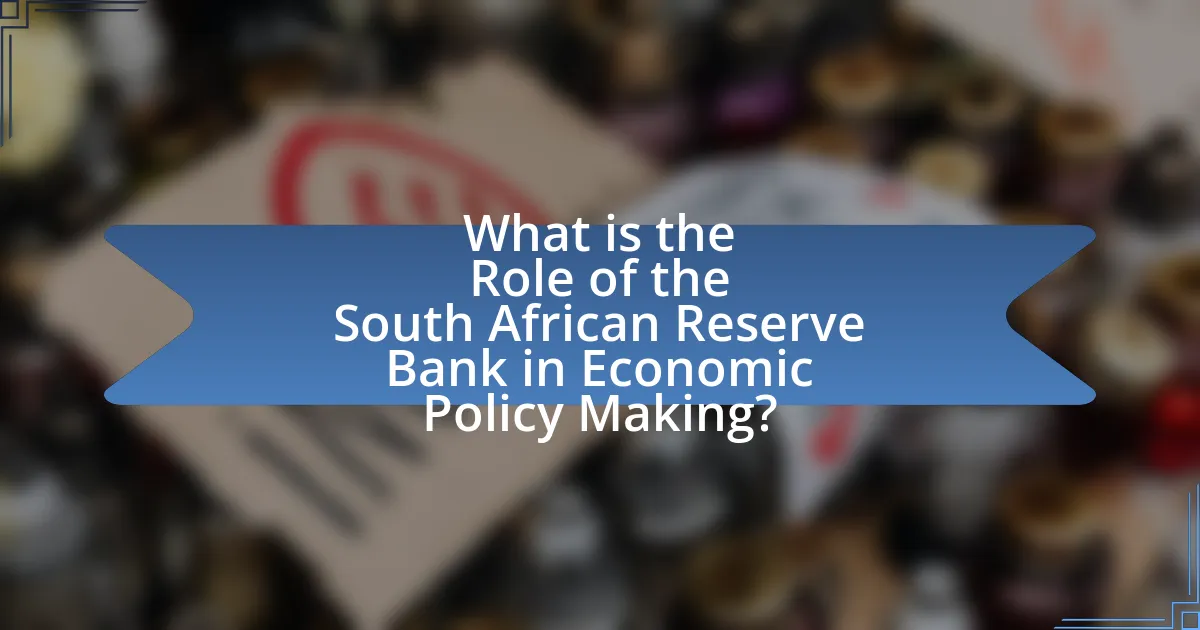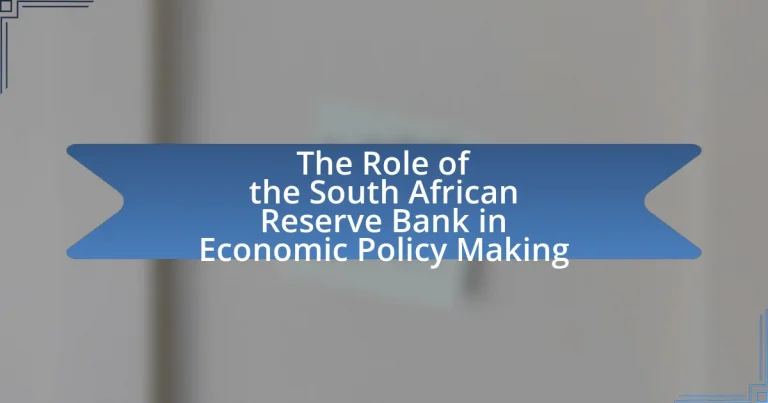The South African Reserve Bank (SARB) is a pivotal institution in the formulation and implementation of monetary policy aimed at achieving price stability and fostering economic growth in South Africa. The article outlines the SARB’s primary objectives, including maintaining the value of the currency through interest rate adjustments and inflation targeting, as mandated by the South African Reserve Bank Act of 1989. It discusses the tools employed by the SARB, such as open market operations and reserve requirements, and examines the impact of interest rate adjustments on the economy. Additionally, the article highlights the SARB’s collaboration with the National Treasury and international financial organizations, the challenges it faces in economic policy making, and the importance of transparency and public perception in enhancing the effectiveness of its policies.

What is the Role of the South African Reserve Bank in Economic Policy Making?
The South African Reserve Bank (SARB) plays a crucial role in economic policy making by formulating and implementing monetary policy aimed at achieving price stability and supporting economic growth. The SARB’s primary objective is to maintain the value of the currency, which it does through interest rate adjustments and inflation targeting, as outlined in the South African Reserve Bank Act of 1989. By setting the repo rate, the SARB influences borrowing costs, consumer spending, and investment, thereby impacting overall economic activity. Additionally, the SARB collaborates with the National Treasury and other government entities to ensure cohesive economic policy, contributing to financial stability and sustainable economic development in South Africa.
How does the South African Reserve Bank influence monetary policy?
The South African Reserve Bank influences monetary policy primarily through the setting of interest rates. By adjusting the repo rate, which is the rate at which the central bank lends to commercial banks, the Reserve Bank can control inflation and stabilize the currency. For instance, in July 2023, the Reserve Bank raised the repo rate to 8.25% to combat rising inflation, demonstrating its active role in managing economic conditions. This adjustment impacts borrowing costs, consumer spending, and overall economic growth, thereby shaping the monetary landscape of South Africa.
What tools does the South African Reserve Bank use to implement monetary policy?
The South African Reserve Bank implements monetary policy primarily through interest rate adjustments, open market operations, and reserve requirements. Interest rate adjustments involve changing the repo rate, which influences borrowing costs and spending in the economy. Open market operations consist of buying and selling government securities to regulate liquidity in the banking system. Reserve requirements dictate the minimum reserves each bank must hold, impacting their ability to lend. These tools are essential for controlling inflation and stabilizing the currency, as evidenced by the Reserve Bank’s mandate to maintain price stability and support economic growth.
How does interest rate adjustment affect the economy?
Interest rate adjustment significantly impacts the economy by influencing borrowing costs, consumer spending, and investment levels. When the South African Reserve Bank raises interest rates, it typically leads to higher loan costs, which can reduce consumer spending and slow down economic growth. Conversely, lowering interest rates decreases borrowing costs, encouraging spending and investment, which can stimulate economic activity. Historical data shows that during periods of low interest rates, such as post-2008 financial crisis, South Africa experienced increased consumer credit and investment, contributing to economic recovery. Thus, interest rate adjustments are a crucial tool for managing economic stability and growth.
What are the primary objectives of the South African Reserve Bank?
The primary objectives of the South African Reserve Bank are to achieve and maintain price stability in the interest of balanced and sustainable economic growth. This objective is enshrined in the South African Reserve Bank Act of 1989, which mandates the bank to protect the value of the currency in the interest of the economic well-being of the country. Additionally, the Reserve Bank aims to promote financial stability and ensure the effective functioning of the financial system, which is crucial for fostering economic development and maintaining public confidence in the financial sector.
How does the South African Reserve Bank ensure price stability?
The South African Reserve Bank ensures price stability primarily through its inflation targeting framework. This framework sets a specific inflation target, which is currently aimed at keeping inflation between 3% and 6%. The Reserve Bank uses monetary policy tools, such as adjusting interest rates, to influence economic activity and inflation levels. For instance, when inflation rises above the target range, the Bank may increase interest rates to cool down spending and investment, thereby reducing inflationary pressures. This approach is supported by the Bank’s commitment to transparency and regular communication with the public, which helps manage inflation expectations.
What role does the South African Reserve Bank play in financial stability?
The South African Reserve Bank (SARB) plays a crucial role in maintaining financial stability by implementing monetary policy, regulating financial institutions, and overseeing payment systems. SARB’s primary objective is to achieve and maintain price stability, which is essential for fostering a stable economic environment. By controlling inflation through interest rate adjustments, SARB influences economic activity and consumer confidence. Additionally, SARB supervises banks and financial institutions to ensure their soundness and compliance with regulations, thereby reducing systemic risks. The bank also monitors and manages the payment systems to facilitate efficient transactions, further contributing to overall financial stability.
How does the South African Reserve Bank collaborate with other economic institutions?
The South African Reserve Bank collaborates with other economic institutions through various mechanisms, including participation in policy forums, data sharing, and joint research initiatives. For instance, the Reserve Bank engages with the National Treasury and the Financial Sector Conduct Authority to align monetary and fiscal policies, ensuring a cohesive approach to economic stability. Additionally, the Reserve Bank is a member of international organizations such as the International Monetary Fund and the Bank for International Settlements, which facilitates knowledge exchange and best practices in monetary policy. This collaboration is crucial for addressing economic challenges and enhancing the effectiveness of policy measures in South Africa.
What is the relationship between the South African Reserve Bank and the National Treasury?
The South African Reserve Bank (SARB) and the National Treasury have a collaborative relationship focused on economic stability and policy implementation. The SARB is responsible for monetary policy, aiming to maintain price stability, while the National Treasury manages fiscal policy, overseeing government spending and revenue collection. This partnership is essential for coordinating monetary and fiscal policies to achieve broader economic goals, such as sustainable growth and financial stability. The effectiveness of this relationship is evidenced by joint efforts in managing inflation and responding to economic challenges, ensuring that both institutions work towards a common economic framework.
How does the South African Reserve Bank engage with international financial organizations?
The South African Reserve Bank engages with international financial organizations primarily through participation in global financial forums and collaboration on monetary policy. This includes active involvement in institutions such as the International Monetary Fund (IMF) and the World Bank, where the Reserve Bank contributes to discussions on economic stability and financial regulation. Additionally, the South African Reserve Bank collaborates with the Bank for International Settlements (BIS) to enhance financial system resilience and shares data and research to inform policy decisions. This engagement is crucial for aligning South Africa’s monetary policy with international standards and practices, thereby fostering economic stability and growth.
What challenges does the South African Reserve Bank face in economic policy making?
The South African Reserve Bank faces several challenges in economic policy making, including high inflation rates, currency volatility, and socio-economic disparities. High inflation, which reached 7.8% in July 2022, complicates the bank’s ability to maintain price stability while supporting economic growth. Currency volatility, particularly against major currencies like the US dollar, affects trade and investment decisions, making it difficult for the bank to implement effective monetary policies. Additionally, socio-economic disparities, characterized by high unemployment rates and inequality, hinder the bank’s efforts to create inclusive economic policies that benefit all citizens. These challenges require the Reserve Bank to navigate complex economic conditions while balancing multiple objectives.
How do external economic shocks impact the South African Reserve Bank’s policy decisions?
External economic shocks significantly influence the South African Reserve Bank’s policy decisions by prompting adjustments in interest rates and monetary policy to stabilize the economy. For instance, during the global financial crisis of 2008, the Reserve Bank lowered interest rates to stimulate economic growth and counteract the negative effects of reduced foreign investment and trade. Additionally, fluctuations in commodity prices, particularly in gold and platinum, can lead to changes in inflation expectations, which the Reserve Bank must address to maintain price stability. This responsiveness to external shocks is crucial for safeguarding the South African economy against volatility and ensuring sustainable growth.
What are the implications of political influences on the South African Reserve Bank?
Political influences on the South African Reserve Bank can lead to compromised monetary policy independence and potential instability in economic management. When political entities exert pressure on the Reserve Bank, it may prioritize short-term political goals over long-term economic stability, which can result in inflationary pressures or currency devaluation. For instance, during periods of political instability, such as the leadership changes within the African National Congress, the Reserve Bank has faced challenges in maintaining its inflation targeting framework, which is crucial for economic stability. This dynamic illustrates how political influences can disrupt the bank’s primary mandate of ensuring price stability and fostering economic growth.
How does the South African Reserve Bank communicate its policies to the public?
The South African Reserve Bank communicates its policies to the public through various channels, including press releases, public statements, and reports. These communications are designed to provide transparency regarding monetary policy decisions and economic outlooks. For instance, the Bank publishes a quarterly Monetary Policy Review that outlines its policy stance and economic assessments, ensuring that stakeholders are informed about its objectives and actions. Additionally, the Reserve Bank holds regular press conferences following monetary policy meetings, where officials explain decisions and respond to media inquiries, further enhancing public understanding of its policies.
What strategies does the South African Reserve Bank use for transparency and accountability?
The South African Reserve Bank employs several strategies for transparency and accountability, including regular public communication, publication of reports, and stakeholder engagement. The bank releases quarterly monetary policy statements and annual reports that detail its policy decisions and economic assessments, ensuring that the public and markets are informed about its actions. Additionally, the Reserve Bank conducts public forums and engages with various stakeholders, including financial institutions and the public, to foster dialogue and gather feedback. These practices are designed to enhance trust and understanding of the bank’s objectives and operations, thereby reinforcing its commitment to transparency and accountability in its role in economic policy making.
How does public perception affect the effectiveness of the South African Reserve Bank’s policies?
Public perception significantly affects the effectiveness of the South African Reserve Bank’s policies by influencing public trust and compliance with monetary measures. When the public perceives the Reserve Bank as credible and transparent, it is more likely to support its policies, such as interest rate adjustments and inflation targeting. For instance, a survey by the South African Reserve Bank in 2021 indicated that 70% of respondents believed that effective communication from the bank enhances their understanding of monetary policy, which in turn fosters greater public adherence to these policies. Conversely, negative perceptions can lead to skepticism and reduced effectiveness, as seen during periods of economic uncertainty when public confidence wanes, resulting in lower compliance with policy measures aimed at stabilizing the economy.
What best practices can be adopted by the South African Reserve Bank for effective economic policy making?
The South African Reserve Bank can adopt several best practices for effective economic policy making, including enhancing data transparency, fostering stakeholder engagement, and implementing a robust framework for policy evaluation. Enhancing data transparency allows for informed decision-making by providing clear and accessible economic indicators, which can be seen in the Reserve Bank’s regular publication of inflation and growth forecasts. Fostering stakeholder engagement involves collaborating with various economic sectors and the public to gather diverse perspectives, as evidenced by the Reserve Bank’s consultations with business and labor organizations. Implementing a robust framework for policy evaluation ensures that policies are assessed for their effectiveness and adjusted as necessary, a practice supported by the Bank’s commitment to regular reviews of its monetary policy stance in response to changing economic conditions.


